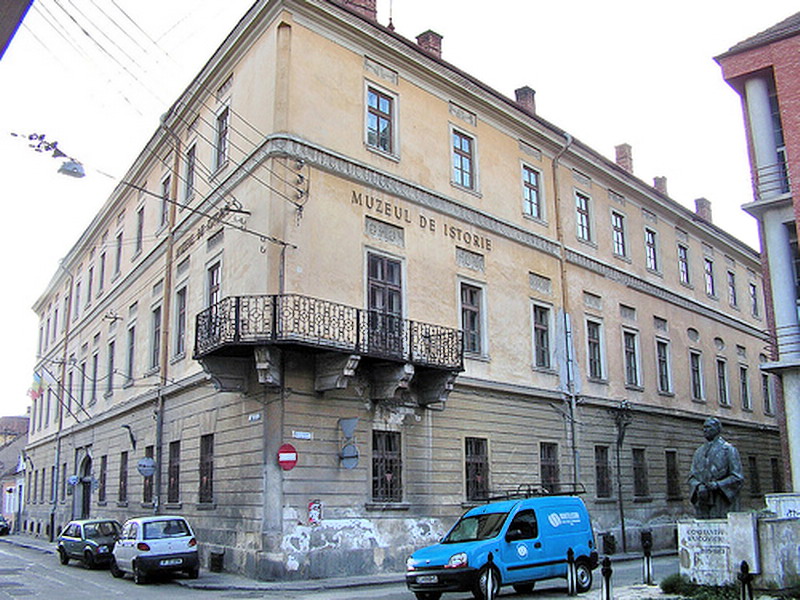Petrichevich-Horváth Dániel House, National Museum of History of Transylvania
Muzeul Național de Istorie a Transilvaniei
Petrichevich-Horváth Dániel House, National Museum of History of Transylvania
Muzeul Național de Istorie a Transilvaniei
Address:
Strada Constantin Daicoviciu 2
Historical Hungarian county:
Kolozs
GPS coordinates:
46.7715553938, 23.5864302975
History
The idea of establishing a Transylvanian Museum was born in the mind of Count Kemény József (1795-1855), who in 1842 offered his own collection of books, documents and minerals for the establishment of a museum. After his death, Count Mikó Imre (1805-1876) donated his villa in a 10-acre ornamental garden for the establishment of a museum. Thus, in 1859, the Transylvanian Museum was founded and the Transylvanian Museum Society was established to expand the exhibits. The Mikó villa soon proved cramped. Some of the exhibits were kept at the university. In 1930, the Romanian state bought the house of Petrichevich-Horváth Dániel, a patron of Hungarian theatre in Kolozsvár, and gave it to the university for use. In 1962, the History Museum was established, now known as the Transylvanian National History Museum.
{"item":"sight","set":{"sightId":1410,"townId":61,"active":1,"name_LO":"Muzeul Na\u021bional de Istorie a Transilvaniei","address":"Strada Constantin Daicoviciu 2","mapdata":"1|1654|761","gps_lat":"46.7715553938","gps_long":"23.5864302975","religion":0,"oldtype":"53","newtype":"98","homepage":"https:\/\/www.mnit.ro\/","openinghours":"https:\/\/www.mnit.ro\/orar-de-vizitare-si-tarife\/","muemlekemlink":"","csemadoklink":"","picture":"\u003Ca title=\u0022Pasztilla, CC BY-SA 3.0 <http:\/\/creativecommons.org\/licenses\/by-sa\/3.0\/>, via Wikimedia Commons\u0022 href=\u0022https:\/\/commons.wikimedia.org\/wiki\/File:Kv%C3%A1r_T%C3%B6rt%C3%A9nelmi_m%C3%BAzeum.jpg\u0022\u003E\u003Cimg width=\u0022512\u0022 alt=\u0022Kv\u00e1r T\u00f6rt\u00e9nelmi m\u00fazeum\u0022 src=\u0022https:\/\/upload.wikimedia.org\/wikipedia\/commons\/b\/bc\/Kv%C3%A1r_T%C3%B6rt%C3%A9nelmi_m%C3%BAzeum.jpg\u0022\u003E\u003C\/a\u003E","picture_ref":"\u003Ca href=\u0022https:\/\/commons.wikimedia.org\/wiki\/File:Kv%C3%A1r_T%C3%B6rt%C3%A9nelmi_m%C3%BAzeum.jpg\u0022\u003EPasztilla\u003C\/a\u003E, \u003Ca href=\u0022http:\/\/creativecommons.org\/licenses\/by-sa\/3.0\/\u0022\u003ECC BY-SA 3.0\u003C\/a\u003E, via Wikimedia Commons","name":"Petrichevich-Horv\u00e1th D\u00e1niel House, National Museum of History of Transylvania","note":"","history":"The idea of establishing a Transylvanian Museum was born in the mind of Count Kem\u00e9ny J\u00f3zsef (1795-1855), who in 1842 offered his own collection of books, documents and minerals for the establishment of a museum. After his death, Count Mik\u00f3 Imre (1805-1876) donated his villa in a 10-acre ornamental garden for the establishment of a museum. Thus, in 1859, the Transylvanian Museum was founded and the Transylvanian Museum Society was established to expand the exhibits. The Mik\u00f3 villa soon proved cramped. Some of the exhibits were kept at the university. In 1930, the Romanian state bought the house of Petrichevich-Horv\u00e1th D\u00e1niel, a patron of Hungarian theatre in Kolozsv\u00e1r, and gave it to the university for use. In 1962, the History Museum was established, now known as the Transylvanian National History Museum.","town":{"townId":61,"name_HU":"Kolozsv\u00e1r","name_LO":"Cluj-Napoca","seolink":"kolozsvar-cluj-napoca","oldcounty":32,"country":4}},"language":"en","region":"romania","regionid":4,"offer":[],"gallery":false,"album":false}

